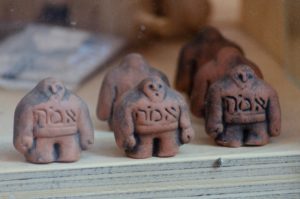Caleb Horowitz | Hey Alma
The word “golem” only appears once in the Tanakh: Psalm 139, verse 16, where it means “my substance, yet being unperfect.” The word describes an unfinished state of being — something unformed, wrapped up, not yet unfurled. In the Christian Bible I read growing up, the New Living Translation, this “unfinished substance” became “You saw me before I was born.” I think of all that was lost in this translation. In the Talmud, Adam was a golem once. Before he was finished, he was incomplete, his dust “kneaded into a shapeless husk.”

I became interested in golems, the Jewish mythical creatures made of clay, in college. The word itself conjures up a specific, uncomfortable memory: I am in a comic-writing class in the creative writing department of my university, drawing my golems in a small notebook, figuring out dialogue to convey a creature yearning for God. We are in groups discussing the most recently assigned text — Art Spiegelman’s “Maus.” A woman in my discussion group tells me, “My husband is Jewish. He lost relatives in the Holocaust.” She sounds almost proud. I nod. “I lost relatives too,” I tell her. “My father’s family fled Poland before the Holocaust, so I don’t even know the names of the family we lost, but I know we lost them.” “Is it just your Dad who’s Jewish?” she asks. “Yes,” I say. “Then you’re not really Jewish,” she says. I don’t have the words to answer. I have just communicated the void of an immense loss — the gaping pit that consumed my father’s family. “You’re not really Jewish,” she says. I focus on the intricate linework of my golem.
Sometimes I think of golems as a kind of secret code. To me, if someone is interested in golems, it means they are both Jewish and a writer. Jewish writers are drawn to the golem like moths to a flame. David Wisniewski, Helene Wecker, Michael Chabon. But it means more than that too. For me, golems represent Jews yearning to understand complex questions about identity. The golem is a being of vast symbolic possibilities, a creature suspended between two places, and this suspension has made it a potent and flexible symbol. For some, to be a queer Jew is to see yourself in the golem. For me, the golem represents what it means to be a patrilineal Jew.
The story goes that in the 16th century, Rabbi Judah Loew ben Bezalel built a golem to defend Prague from a pogrom. The rabbi created a creature out of clay. He etched a single word across its head — emet, truth — and it came to life. Some stories say that the golem ceased to listen to the rabbi and became murderous. To stop his creation’s violence, the rabbi blotted the first letter from the golem’s head, leaving only met, meaning death.
I feel that I understand the kabbalists and their word magic. Language is life. We are all bundles of words. And in college, as I discovered myself as a writer, one of the words I wanted desperately to call my own was “Jew.”
I grew up in what many would call an interfaith household. My father converted to Christianity after marrying my mother, but his heritage and childhood traditions were important to him, so, alongside our Christian holidays, we celebrated some Jewish ones too. There was Christmas and Hanukkah, Passover and Easter. We did not observe the more solemn holidays — Yom Kippur was conspicuously absent. I think my father found something in my mother’s faith he had felt missing from his own as a child, perhaps a sense of belonging. I felt the opposite. As I grew older, Christianity began to feel more and more foreign to me. By college, I was an agnostic. By graduation, I was a Jew.
Many patrilineal Jews are raised as Jews and are still denied their own heritage by the Jews and non-Jews around them. I was not in this boat. I was raised Christian, and so while I acknowledge I have Jewish heritage, embracing Judaism in its entirety was a choice. I have so many things to unlearn and untangle, from the supercessionist teachings of my old church to a childhood filled with cultural practices that toed the line between cultural appropriation and the genuine and sincere attempts of two people of different backgrounds to give their children pieces of themselves. I was not offended when a rabbi told me, “You are not Jewish yet, but you can be if you want.” But I was, however, a bit perturbed. Sure, I had plenty of work to do before becoming a part of this new tradition, but would the same thing have been said if it were my mother who had been raised Jewish and had converted to Christianity, or would I have simply been welcomed back to Judaism with open arms, perhaps even told I had been Jewish the whole time?
I have always seen the figure of the golem as somebody yearning for something outside of themselves, a figure yearning for God. Perhaps this comes from the Talmud (Sanhedrin 38b), in which the word “golem” is defined as a “body without a soul.” Perhaps it has to do with the ambiguity of the golem’s humanness. If you search for images of golems, you will find everything from monstrous hulking creatures of clay to surprisingly humanoid figures. The golem is both person and creature, human and beast.
I imagine the golem, created to defend Jews, struggling with whether or not it is itself a Jew. Wrestling like Jacob with God for answers. I picture a golem that feels internally fractured, a creature created by a Jewish father — the rabbi — but with no mother; a creature whose status as a Jew is always in flux. Golems are enigmatic, symbolically confusing — messy; half-Jewish. The golem’s inheritance is complex and not halakhically recognized. Why did the golem lose faith in its father? Why did the golem rebel after saving the Jewish people? Did it perhaps feel that it was not Jewish enough?
We live in a world of undeniable mixture, of people who contain cultural multitudes. It is irresponsible to look at the world and insist on a “purer” kind of Jew. It is, quite frankly, dangerous. Patrilineal Jews live in a terrifying, liminal space between Jewish institutions that do not accept them as Jews and an antisemitic world that insists that they are. Is it any wonder I found solace in the golem, half-Jewish, lonely, God-searching? When I looked at the golem, I saw myself.
I have learned to see myself as whole-Jewish. Not just based on a decision to convert, but also because I have made up my mind about myself. I am God’s “substance, yet being unperfect,” and I am working toward something that finds the wholes in halves, the Jewishness of the golem perfectly realized in its imperfection. I am working toward the Jewishness that I want for myself, that I must snatch from the universe and hold tight.
For more articles like this, visit HeyAlma.com.
Caleb Horowitz is a high school speech instructor and English academic. Via Hey Alma/JTA.







